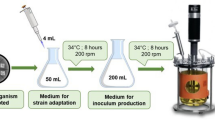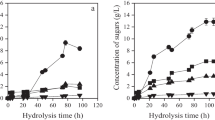Abstract
Liquid residues from beer (RB) and potato (RP) processing were evaluated as carbon sources for the production of docosahexaenoic acid (C22:6n-3, DHA) by two native Thraustochytriidae sp., M12-X1 and C41, in shaking flask experiments. Results were compared with those obtained in the fermentations of glucose, maltose, soluble starch and ethanol. Both strains produced the highest biomass concentration (2.3 g/L) in the fermentation of RB supplemented with nitrogen sources [yeast extract (YE) and monosodium glutamate (MSG)]. DHA content in the fatty acids produced by the native thraustochytrids was dependent on the fermented carbon source; the fatty acids from biomass grown on carbon sources that permitted a lower growth rate contained more DHA. The highest DHA productivity [55.1 mg/(day L)] was obtained in the fermentation of RB-YE-MSG by M12-X1 strain. In this medium, M12-X1 strain grew at a specific growth rate of 0.014 h−1 and total fatty acid content in the biomass was 41.3%. Production of DHA by M12-X1 strain followed a non-growth rate associated pattern and DHA content in the biomass decreased significantly after growth ceased.


Similar content being viewed by others
References
AOAC (1995) Official methods of analysis of official analytical chemists international, 16th edn. Association of Official Analytical Chemists, Arlington
Bajpai PK, Bajpai P, Ward OP (1991a) Optimization of production of docosahexaenoic acid (DHA) by Thraustochytrium aureum ATCC 34304. J Am Oil Chem Soc 68:509–514
Bajpai P, Bajpai PK, Ward OP (1991b) Production of docosahexaenoic acid by Thraustochytrium aureum. Appl Microbiol Biotechnol 35:706–710
Chisti Y (2007) Biodiesel from microalgae. Biotechnol Adv 25:294–306
Copeman LA, Parrish CC, Brown JA, Harel M (2002) Effects of docosahexaenoic, eicosapentaenoic, and arachidonic acids on the early growth, survival, lipid composition and pigmentation of yellowtail flounder (Limanda ferruginea): a live food enrichment experiment. Aquaculture 210:285–304
Fakas S, Certik M, Papanikolaou S, Aggelis G, Komaitis M, Galiotou-Panayotou M (2007) Compositional shifts in lipid fractions during lipid turnover in Cunninghamella echinulata. Enzym Microb Technol 40:1321–1327
Fan KW, Chen F, Jones EBG, Vrijmoed LLP (2001) Eicosapentaenoic and docosahexaenoic acids production by and okara-utilizing potential of thraustochytrids. J Ind Microbiol Biotechnol 27:199–202
FAO Fisheries Department, Food and Agriculture Organization of the United Nations, Rome
Hinzpeter I (2008) Identification of microorganisms of Thraustochytriales order from the coastal zone in Puerto Montt, Chile, and determination of their potential for the production of docosahexaenoic acid. Doctoral thesis at Natural Resource Science Doctorate Program. Universidad de La Frontera
Huang J, Aki T, Yocochi T, Nakahara T, Honda D, Kawamoto S, Shigeta S, Ono K, Suzuki O (2003) Grouping newly isolated docosahexaenoic acid-producing thraustochytrids based on their polyunsaturated fatty acid profiles and comparative analysis of 18S rRNA genes. Mar Biotechnol 5:450–457
Lewis TE, Nichols PD, McMeekin TA (2000) Evaluation of extraction methods for recovery of fatty acids from lipid-producing microheterotrophs. J Microbiol Methods 43:107–116
Lim GP, Calon F, Morihara T, Yang FS, Teter B, Ubeda O, Salem N, Frautschy SA, Cole GM (2005) A diet rich with omega-3 fatty acid docosahexaenoic acid reduces amyloid burden in an aged Alzheimer mouse model. J Neurosci 25:3032–3040
Meng X, Yang J, Xu X, Zhang L, Nie Q, Xian M (2009) Biodiesel production from oleaginous microorganisms. Renew Energy 34:1–5
Miao X, Wu Q (2006) Biodiesel production from heterotrophic microalgal oil. Bioresour Technol 97:841–846
Morris DL (1948) Quantitative determination of carbohydrates with Dreywood’s anthrone reagent. Science 107:254–255
Rees JF, Cure K, Piyatiratitivorakul S, Sorgeloos P, Menasveta P (1994) Highly unsaturated fatty acid requirements of Penaeus monodon postlarvae: an experimental approach based on Artemia enrichment. Aquaculture 122:193–207
Salhi M, Izquierdo MS, Hernandez Cruz CM, González M, Fernandez Palacios H (1994) Effect of lipid and n-3 HUFA levels in microdiets on growth, survival and fatty acid composition of larval Gilthead seabream (Sparus aurata). Aquaculture 124:275–282
Stevens L, Zhang W, Peck L, Kuczek T, Grevstad N, Mahon A, Zentall SS, Arnold LE, Burgess JR (2003) EFA supplementation in children with inattention, hyperactivity, and other disruptive behaviors. Lipids 38:1007–1021
Tacon AGJ, Hasan MR, Subasinghe RP (2006) Use of fishery resources as feed inputs to aquaculture development: trends and policy implications. FAO Fisheries Circular No. 1018
Turchini GM, Torstensen BE, Ng WK (2009) Fish oil replacement in finfish nutrition. Rev Aquac 1:10–57
Uauy R, Hoffmann DR, Peirano P, Birch DG, Birch EE (2001) Essential fatty acids in visual and brain development. Lipids 36:885–895
Unagul P, Assantachai C, Phadungruengluij S, Suphantharika M, Tanticharoen M, Verduyn C (2007) Coconut water as a medium additive for the production of docosahexaenoic (C22:6n3) by Schizochytrium mangrovei Sk-02. Bioresour Technol 98:281–287
Yaguchi T, Tanaka S, Yokochi T, Nakahara T, Higashihara T (1997) Production of high yields of docosahexaenoic acid by Schizochytrium sp. strain SR21. J Amer Oil Chem Soc 74:1431–1434
Yamasaki T, Aki T, Shinozaki M, Taguchi M, Kawamoto S, Ono K (2006) Utilization of shochu distillery wastewater for production of polyunsaturated fatty acids and xanthophylls using thraustochytrid. J Biosci Bioeng 102:323–327
Yokochi T, Honda D, Higashihara T, Nakahara T (1998) Optimization of docosahexaenoic acid production by Schizochytrium limacinum SR21. Appl Microbiol Biotechnol 49:72–76
Acknowledgments
This work is part of the doctoral thesis of MSc Benita Quilodran at Programa de Doctorado en Ciencias de Recursos Naturales, Universidad de La Frontera, Temuco, Chile. The authors acknowledge the economical support provided by Dirección de Investigación, Universidad de Los Lagos through Project No 0001906 and Project MECESUP ULA 0202. The authors also acknowledge Mr. Alberto Peters (Casa Cervecera Puerto Montt) for providing the brewery by-product.
Author information
Authors and Affiliations
Corresponding author
Rights and permissions
About this article
Cite this article
Quilodrán, B., Hinzpeter, I., Quiroz, A. et al. Evaluation of liquid residues from beer and potato processing for the production of docosahexaenoic acid (C22:6n-3, DHA) by native thraustochytrid strains. World J Microbiol Biotechnol 25, 2121–2128 (2009). https://doi.org/10.1007/s11274-009-0115-2
Received:
Accepted:
Published:
Issue Date:
DOI: https://doi.org/10.1007/s11274-009-0115-2




